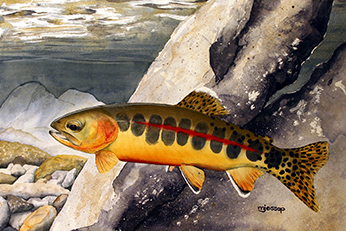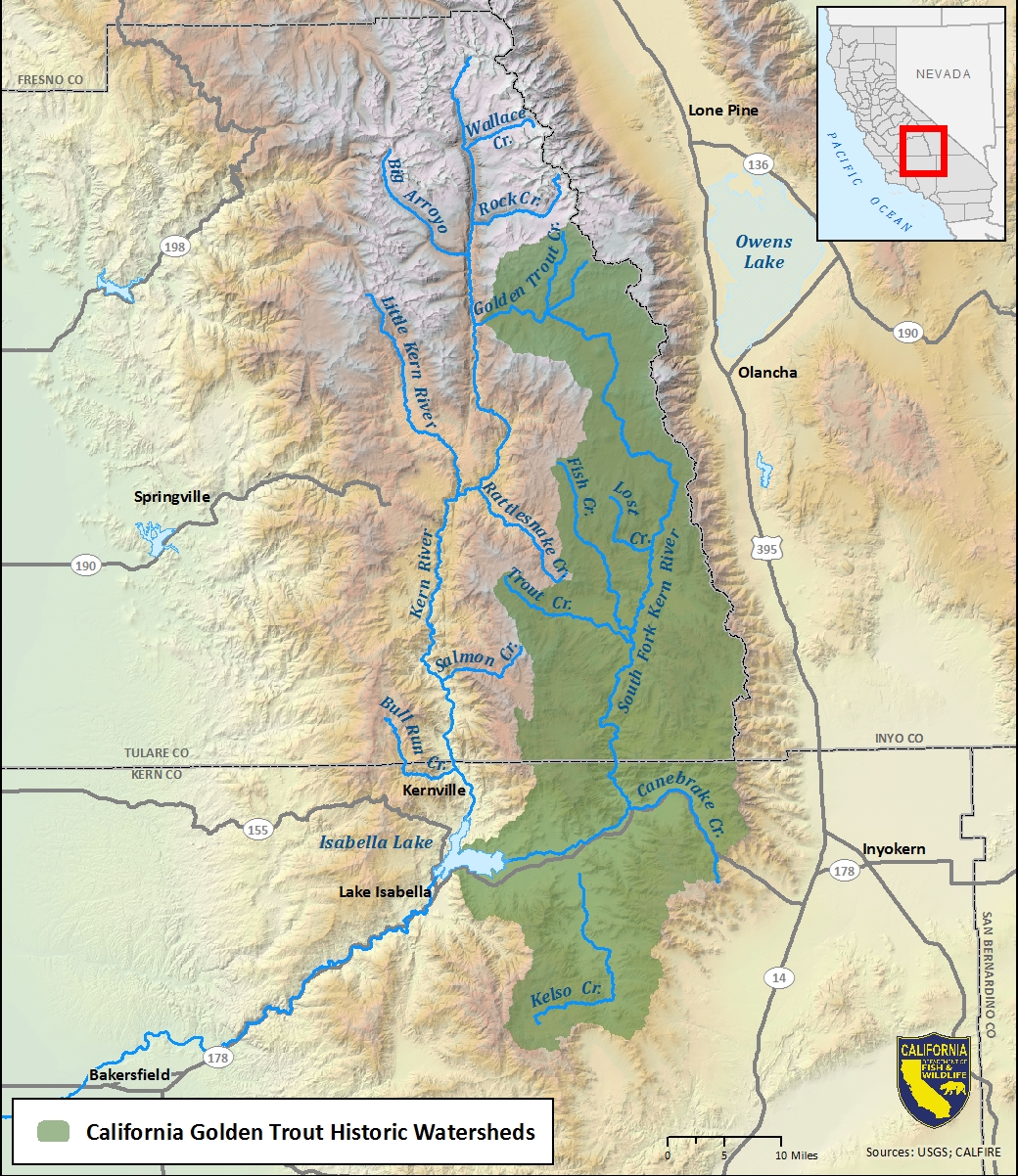Oncorhynchus aguabonita
Distribution and Habitat
 © Mark Jessop, all rights reserved.
© Mark Jessop, all rights reserved.
California golden trout are native to two stream systems on the eastern side of the Kern River: Golden Trout Creek and the South Fork Kern River (Tulare County). Golden Trout Creek is thought to have once formed the headwaters of the South Fork Kern River but, due to volcanic activity thousands of years ago, it was diverted west near Tunnel Meadow and now flows directly to the Kern River.
The South Fork Kern River is quite large and flows from the western crest of the Sierra Nevada, near Cottonwood Pass, downstream to the Kern River where Lake Isabella now exists. It is unknown how far downstream California golden trout were historically distributed and the only documentation is from longtime Kernville resident, Ardis Walker. As a boy, fishing the South Fork Kern River in 1913, he reported catching California golden trout in the "gorge" just upstream of the Bloomfield Ranch, near the southern boundary of the Domeland Wilderness. It is thought that California golden trout may have extended downstream of Lake Isabella prior to the construction of Isabella Dam. The lower limits of their range probably changed depending on climatic conditions and seasonal water temperatures. It is unknown whether California golden trout naturally occurred in the Kern River, although it is likely that some level of movement occurred between these formerly connected rivers.
Due to their singular beauty and popularity as a unique sport fish, California golden trout have been widely distributed outside their native range, mostly in high elevation lakes and streams in the Sierra Nevada. They were also transplanted to numerous lakes in the Wind River Range in Wyoming. In about 1872, according to an old newspaper account, a transplant was made from Golden Trout Creek into the headwaters of Mulkey Creek. Although Mulkey Creek is a tributary to the South Fork Kern River, a natural barrier prevented movement of California golden trout into the headwaters. This area, Mulkey Meadows, was probably fishless until the 1872 transplant.
In 1876, 13 golden trout from Mulkey Creek were put into a “coffee can,” carried over the divide, and stocked into Cottonwood Creek; 12 survived the trip. Cottonwood Creek drains the eastern side of the Sierra Nevada to the Owens Valley and was fishless prior to the transplant. Later, trout from Cottonwood Creek were transplanted into Cottonwood Lakes, creating broodstock for almost all subsequent propagation and distribution of California golden trout throughout California and beyond.
 Map of California golden trout historic watershed.
Map of California golden trout historic watershed.
Threats
California golden trout are threatened by non-native trout and land use impacts from long-term and historically-intensive grazing activities.
Conservation and Management
Major efforts were made since the 1960s to create refuge areas in the upper reaches of the South Fork Kern River. Three barriers were built (Ramshaw, Templeton, and Schaeffer) and a piscicide was applied to the river to kill all non-native fish above or between these barriers. From 1969 through 2000, 10 chemical treatments were performed, with varying degrees of success.
In addition, gill netting of select headwater lakes such as Chicken Spring and Rocky Basin lakes occurred to remove hybridized fish. These were successful and these lakes are now fishless. A Conservation Assessment and Strategy for California Golden Trout (2004 - PDF) was adopted to protect and restore California golden trout populations, expand their distribution within their native range, improve habitat, and increase educational efforts.
Cattle grazing allotments were reduced in recent decades and, in some cases, they were rested or eliminated to protect sensitive habitats. Cattle exclusion fencing is maintained in several areas to keep cows out of the stream. Other habitat improvement projects are underway and scientists are studying the meadow ecosystems and water conditions throughout the Kern Plateau. Population and habitat monitoring for California golden trout and other fishes is an ongoing management activity.
Species Status
Multiple genetic analyses were conducted on California golden trout throughout their range and levels of introgression with rainbow trout vary, depending on location. In general, a hybridization gradient exists in the South Fork Kern River, with introgression levels increasing as you move downstream through the watershed. The highest genetic integrity occurs in Mulkey Creek, in the South Fork Kern River drainage, and in Golden Trout Creek and its tributaries.
California golden trout were proposed to be listed under the Federal Endangered Species Act in 2000 but were determined to not merit listing. This was mainly due to the many conservation actions and protections afforded under a multi-agency conservation strategy. They are currently a State Species of Special Concern.